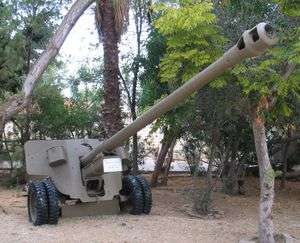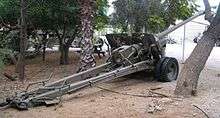100 mm field gun M1944 (BS-3)
The 100 mm field gun M1944 (BS-3) (Russian: 100-мм полевая пушка обр. 1944 г. (БС-3)) was a Soviet 100 mm anti-tank and field gun. The gun was successfully employed in the late stages of World War II, and remained in service into the 1950s, being replaced in Soviet service by the T-12 antitank gun and the 85 mm antitank gun D-48 in 1955. The BS-3 was also sold to a number of other countries and in some of these countries the gun is still in service. A number of BS-3 pieces are still stored in Russian Ground Forces arsenals. Also, in 2012, at least 12 BS-3 guns are active with the 18th Machine Gun Artillery Division, located on the Kuril Islands, used as anti-ship and anti-landing guns.
| 100 mm field gun model 1944 (BS-3) | |
|---|---|
 BS-3 at the Israel Defense Forces History Museum, Israel | |
| Type | Field and anti-tank gun |
| Place of origin | Soviet Union |
| Service history | |
| Wars | World War II Vietnam War Yom Kippur War |
| Production history | |
| Produced | 1944–51 |
| Specifications | |
| Mass | 3,650 kg (8,047 lbs) |
| Length | 9.37 m (30 ft 9 in)[1] |
| Barrel length | Bore: 5.34 m (17 ft 6 in) L/53.5 Overall: 5.96 m (19 ft 7 in) L/59.6 (with muzzle brake) |
| Width | 2.15 m (7 ft 1 in)[1] |
| Height | 1.5 m (4 ft 11 in)[1] |
| Crew | 6 to 8 |
| Shell | Fixed QF 100 × 695 mmR[1] |
| Caliber | 100 mm (3.93 in) |
| Breech | Semi-automatic vertical sliding-wedge[1] |
| Recoil | hydro-pneumatic[1] |
| Carriage | Split trail |
| Elevation | -5° to 45° |
| Traverse | 58° |
| Rate of fire | 8 to 10 rpm |
| Muzzle velocity | 900 m/s (2,953 ft/s) |
| Maximum firing range | 20 km (12.42 mi) |
History

The BS-3 was based on the B-34 naval gun. The development team was led by V. G. Grabin.
The gun was employed by light artillery brigades of tank armies (20 pieces along with 48 ZiS-3) and by corps artillery.
In the Second World War the BS-3 was successfully used as a powerful anti-tank gun. It was capable of defeating any contemporary tank at long range, excluding the Tiger Ausf B: to destroy that heavy tank the gun needed to shoot at less than 1600 m from the target. The gun was capable of defeating the glacis of Tiger II at a range of 500-600 metres and its Turret at 1500 meters.[2]
The gun was also used as a field gun. Though in this role it was less powerful than the 122 mm A-19, as it fired a smaller round, the BS-3 was more mobile and had a higher rate of fire.
Ammunition data
- Ammunition
- AP: BR-412
- APBC: BR-412B, BR-412D
- HE/Fragmentation
- Projectile weight
- AP/APBC: 15.88 kg (35 lbs)
- HE/Fragmentation: 15.6 kg (34.39 lbs)
- Armor penetration (BR-412B, 30° degrees)
- 500 m : 190 mm
(547 yds : 6.29 in) - 1000 m : 170 mm
(1,093 yds : 6 in)
- 500 m : 190 mm
Operators
See also
- 100 mm vz. 53 - A similar Czech anti-tank gun using the same ammunition.
- D-10 tank gun
- 8.8 cm KwK 43- A contemporary German tank gun with similar performance
Notes
- Foss, Christopher (1977). Jane's pocket book of towed artillery. New York: Collier. p. 59. ISBN 0020806000. OCLC 911907988.
- "english.battlefield.ru". Retrieved 2009-10-20.
- http://armstrade.sipri.org/armstrade/page/trade_register.php
- Schuster, Carl Otis; Coffey, David (May 2011). "Vietnam, Democratic Republic of, Army". In Tucker, Spencer C. (ed.). The Encyclopedia of the Vietnam War: A Political, Social, and Military History (2 ed.). p. 1251. ISBN 978-1-85109-960-3.
References
- Shunkov V. N. - The Weapons of the Red Army, Mn. Harvest, 1999 (Шунков В. Н. - Оружие Красной Армии. — Мн.: Харвест, 1999.) ISBN 985-433-469-4
- Christopher F. Foss, Artillery of the World
